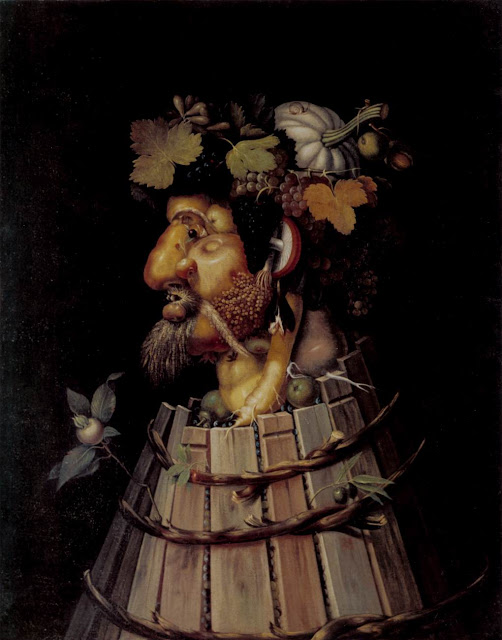 |
| Photograph by Ian Nicholson © |
In a spectacular transformation that is typical of his work, Philip Haas has created a group of large-scale sculptures, inspired by Giuseppe Arcimboldo's renaissance paintings of the four seasons, comprising Spring, Summer, Autumn and Winter. The exhibition runs between 20 June – 16 September 2012.
Giuseppe Arcimboldo (1527 – 1593) was born in Milan in the year 1527. He was part of a rich and important family, including some important archbishops. His career started in the glass workshops of the Milan Cathedral.
From 1562 on, Giuseppe Arcimboldo started working at the Hapsburg imperial court of Ferdinand I. It was here that he created the paintings that he is so well known for. Almost immediately his original fantasy was unleashed. He invented a portrait type consisting of painted animals, flowers, fruit, and objects composed to form a human resemblance. Some are satirical portraits of court personages, others are allegorical personifications.
Arcimboldo's style has been so often imitated over the centuries that it is sometimes difficult to make exact attributions. Some see him as the forerunner of Surrealism in the 20th century, but he should be seen in his own context at the end of the Renaissance. In this time people (collectors and scientists alike) were beginning to pay more attention to nature. Arcimboldo really created the fantastic image of the court in Prague, creating costumes, set designs, and decorations. Emperor Rudolf II gave him countless commissions for paintings and set him the task of researching and buying works of art and natural curiosities as well. In 1587 Arcimboldo returned to Milan but stayed in contact with the Emperor.
Arcimboldo died in 1593 in Milan. Although he was extremely famous during his lifetime, he was soon forgotten after his death. We do not know why people lost interest in his art. Perhaps he was misunderstood by the generations that followed. The interest to his abstruse and fantastic pictures, of which only a few survive today, did revive at the end of the 19th century.
 | ||
| 1566 Air oil on canvas 75 x 56 cm |
 |
| 1566 Fire oil on panel 76 x 51 cm |
 |
| 1566 The Lawyer oil on canvas 64 x 51 cm |
 |
| 1566 Water oil on panel 67 x 52 cm |
 |
| 1570 Earth oil on panel 70 x 49 cm |
 |
| 1573 Spring oil on canvas 76 x 64 cm |
 |
| 1573 Summer oil on canvas 76 x 64 cm |
 |
| 1573 Autumn oil on canvas 93 x 72 cm |
 |
| 1573 Winter oil on canvas 76 x 64 cm |
 |
| 1573 Seated Figure of Summer oil on canvas 64 x 76 cm |
 |
| 1578 Portrait of Adam oil on canvas |
 |
| 1578 Portrait of Eve oil on canvas |
 |
| 1588 Flora oil on panel 73 x 56 cm |
 |
| The Cook oil on canvas 52 x 41 cm |
The Cook has a double illusion - the head (above) sits on a metal dish and wears another metal dish as a hat. When the painting is viewed upside-down the situation is reversed, and a different face appears:
 |
| The Gardener oil on panel 35 x 24 cm |
 |
| The Librarian oil on canvas 97 x 71 cm |
 |
| The Seasons oil on canvas 94 x 73 cm |
+oil+on+panel+68+x+56+cm.jpg) |
| 1590-91 Vertumnus A portrait depicting Rudolph II, Holy Roman Emporer as Vertumnus, the Roman God of the seasons |


it is terrible and awesome also ugly
ReplyDeletePorém criativo!
ReplyDelete